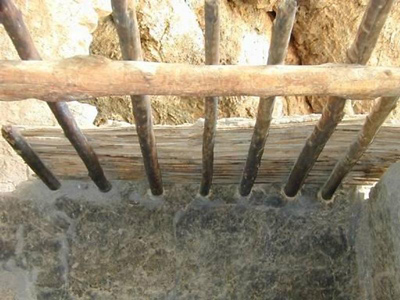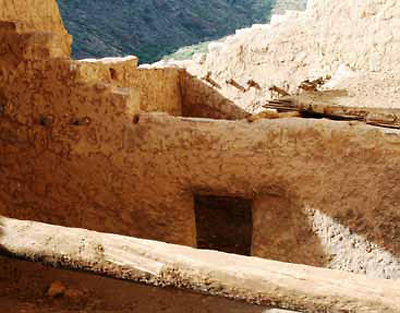Dendrochronology, or tree-ring dating, has assisted archeologists in assigning calendar dates to archeological sites since the early twentieth century. This dating method has played a large and yet disappointing role in assisting archeologists in determining the dates of occupation at the Upper and Lower Cliff Dwellings at Tonto National Monument.
Archeologists have cored the majority of the prehistoric wood located in the two primary cliff dwellings for dendrochronological investigations. However, only a few dates have been acquired from the wood samples. Approximately six confirmed dates have been taken from tree-ring samples at the Monument since 1907 despite hundreds of samples taken. The low number of tree-ring dates obtained from the ruins is mostly due to the presence of non-datable wood, such as sycamore, used by the original inhabitants of the cliff dwellings (Fox 1996).
Exploring the Dendrochronology of Tonto National Monument

NPS
Tonto National Monument is located in central Arizona about two miles southeast of Roosevelt, AZ. President Theodore Roosevelt established the monument in 1907 because of the area’s “great ethnologic, scientific, and educational interest” (Proclamation No.787-Dec. 19, 1907-35 Sta. 2168). The Monument features two primary cliff dwellings, three smaller cliff dwellings and over 60 other significant sites scattered throughout the highlands and lower alluvial plains. The Lower Cliff Dwelling lies at an elevation of 3160 ft (963 m) and the Upper Cliff Dwelling at approximately 3360 ft (1024 m). Archeologists have determined that the Tonto Cliff Dwellings were occupied during the Roosevelt Phase (A.D. 1280-1320) and Gila Phase (A.D. 1320-1450) of the Late Classic Period (Guebard 2006).
The dates ascribed to the Tonto Cliff Dwellings come from the application of several dating methods that include radiocarbon dating, archaeomagnetic dating, ceramic cross-dating, and dendrochronology. Nine different tree-ring sample collection events have occurred at Tonto National Monument beginning with the famous Southwest archeologist Emil Haury (Dean 1995; Windes 2007). The 1995 NPS data recovery and stabilization events at the ruins included a dendrochronological study of the Upper and Lower ruins (Fox 1996). New samples were taken from the Upper Cliff Dwelling and previously collected tree-ring samples were re-analyzed. In 2006, Thomas Windes cored almost all prehistoric wood elements observed in the Lower and Upper Dwellings totaling 72 samples.
|
Date
|
Collector
|
Sample Number
|
|---|---|---|
| May 23, 1935 | Emil W. Haury and E.B. Sayles | GP 771-785 |
| 1937 | Duffen | Ton 1-8 |
| 1950 | Lloyd Pierson | Ton 9-12 |
| May 13, 1958 | John C. McGregor | Ton 13-14 |
| April 25, 1965 | Bryant Bannister | Ton 15-16 |
| Unknown Date | National Park Service | Ton 17 |
| May 22, 1995 | Laboratory of Tree-Ring Research (LTRR) | Ton 18-67 |
| February 21, 1995 | LTRR | Ton 68-69 |
| July, 2007 | Tom Windes | Ton 86-158 (No Ton 111) |
Dendrochronology at the Lower Cliff Dwelling

NPS
The Lower Cliff Dwelling (AZ U:8:47 or TONT 85A-51) includes a 16-room masonry/adobe pueblo built into a large rockshelter. Records available from past coring events at the Lower Cliff Dwelling tend to be poorly documented. Poor documentation makes identifying the exact specimen and location of the older samples difficult (Windes 2007). Of all the previous cores, the samples taken by E. B. Sayles and Emil Haury in May, 1935 proved the most accurately documented, and were relocatable by Windes and his crew in 2006. Sample number GP-771 was a core taken by Haury and Sayles from a Douglas fir located in “Room 5,” which is now designated Room 14. This sample from the Lower Cliff Dwelling dated between A.D. 931-1109vv (the “vv” indicates that there is no way to identify how close the date provided is to the actual cutting or death date of the tree). In 1937, William Duffen took a sample from an unknown room in the Lower Cliff Dwelling that dated to A.D. 1346. In 1995, Gregory Fox (1996) had the University of Arizona Laboratory for Tree-Ring Research (LTRR) collect new samples from the Upper Cliff Dwelling and reanalyze older samples from both ruins. Sample Ton-68 from the 1995 reanalysis was identified as the same as sample GP-771 taken from the Lower Ruin in 1935. The reanalysis of the sample dated the wooden beam between A.D. 919-1109vv. The inclusive date for both samples is A.D. 1109vv and represents a non-cutting date. Regarding this sample, Dean (1995) suggests that “the tree died at least 50 years after A.D. 1160 and probably at least 150 years before the Lower Ruin was built,” indicating that the residents of the Lower Cliff Dwelling may have collected “old wood” rather than cutting living trees for use in building construction. All other tree-ring samples taken from the Lower Cliff Dwelling have not been successfully placed within the dendrochronological series of the region. In November of 2006, Thomas Windes cored almost all prehistoric wood elements in the Lower Cliff Dwelling, but no new dates were acquired (Windes 2007).
|
Collector
|
Collection Date
|
Site Name
|
Sample Number
|
Room Number
|
Sample Date
|
Species
|
Other Information
|
|---|---|---|---|---|---|---|---|
| Haury and Sayles |
1935
|
LCD
|
GP-771
|
5*
|
931-1109vv | Douglas fir | |
| Duffen |
1937
|
LCD
|
Ton 7
|
UNK
|
1346 | Douglas fir | |
| LTRR |
1995
|
LCD
|
Ton-68
|
5
|
919-1109vv | Douglas fir | Confirmation of date from GP-771 – two samples are the same |
| LTRR |
1996
|
LCD
|
Ton-68 / GP-771
|
5
|
1109vv | Douglas fir | Inclusive date for two samples |
| * Sample number GP-771 is reported to have been located in Room 14 of the Lower Cliff Dwelling in Haury’s report. However, the room numbering system used by Haury has been changed. Room 14 is now Room 5. | |||||||
Dendrochronology at the Upper Cliff Dwelling

NPS
The Upper Cliff Dwelling (AZ U:8:48 or TONT 85A-50) consists of a 32-room masonry/adobe pueblo built into a large rockshelter. The site has yielded spectacular cotton textiles as well as impressive lithic tools, ceramic vessels, and intact wooden elements such as vigas and roofs. Five tree-ring dates have been obtained for the Upper Cliff Dwelling. Haury and Sayles collected two samples in 1935. The first date came from a pinyon pine sample, GP-785, that dated between A.D. 1256-1303v (the “v” indicates a probable cutting/death date). The second date came from a Douglas fir sample, GP- 782, most likely taken from Room 19 of the ruin. GP-782 dated very close to A.D. 1346. Haury also collected a juniper sample in 1938 that dated to A.D. 1346. However, this sample does not have a number. The GP-782 and 785 sample dates were confirmed during the 1996 National Park Service project conducted by Gregory Fox. Sample Ton-40 from the Upper Cliff Dwelling Room 19 is the same pinyon pine sample as GP-782 and dated to A.D. 1290vv. The inclusive date for both samples is A.D. 1290vv. Sample GP-785 was reanalyzed and the probable cutting date was determined to be A.D. 1303v (Dean 1995). The most recent date was obtained by Windes in 2007. Sample Ton-137 was taken from a secondary pinyon pine roof beam from Room 5 and this dated to A.D. 1342r (the “r” indicates that most of the outer ring is present, and therefore, that the date reasonably reflects a cutting/death date).
| Collector | Collection Date | Site Name | Sample Number | Room Number | Sample Date | Species / Other Information |
|---|---|---|---|---|---|---|
| Haury and Sayles |
1935
|
UCD
|
GP-785
|
Unknown
|
1256-1303v
|
Pinyon |
| Haury and Sayles |
1935
|
UCD
|
GP-782
|
19/17
|
1346
|
Douglas fir |
| Haury |
1938
|
UCD
|
Haury, 1938
|
5
|
1346
|
Juniper |
| LTRR |
1996
|
UCD
|
Ton-40
|
19
|
1290vv
|
Confirmation of date from GP-782 – the two samples are the same. |
| LTRR |
1996
|
UCD
|
Ton-40 / GP-782
|
19
|
1290vv
|
Inclusive date for two samples |
| LTRR |
1996
|
UCD
|
GP-785
|
Unknown
|
1303v
|
This sample was reanalyzed with results confirming the original. |
| Windes |
2007
|
UCD
|
Ton-137
|
5
|
1342r
|
Pinyon |
Conclusion
In spite of the hundreds of tree-ring samples taken from the Upper and Lower Cliff Dwellings at Tonto National Monument, only a few dates have assisted archeologists in dating the two ruins. The dates that are available place the ruins in their suspected Roosevelt and Gila Phase time periods. Ceramics observed at the ruins, including Roosevelt Red Ware, Salado Red, and Salado White-on-Red, also date to these two time periods, suggesting a Late Classic Period occupation of the Tonto Cliff Dwellings.
Literature Cited
Dean, Jeffery
1995 WALPI Project, letter to Gregory Fox, USDI National Park Service, Western Archeological and Conservation Center, from Laboratory for Tree-Ring Research, University of Arizona, Accession A-1207.
Guebard, Matthew
2006 2005-2006 Dendrochronology and Artifact Collection Research Project, Tonto National Monument. Northern Arizona University Anthropology Laboratories. Manuscript on file, Tonto National Monument, Roosevelt, Arizona.
Fox, Gregory
1996 Archaeological Investigations at the Upper Ruin, Tonto National Monument, Part I: Salvage Excavations at the Upper Ruin-1995. Western Archeological and Conservation Center.
2000 Archeological Investigation of Rooms 15 and 16 at the Upper Cliff Dwelling, Tonto National Monument. Western Archeological and Conservation Center Monument.
Windes, Thomas C.
2007 Structural Wood Study of the Upper and Lower Ruins, Tonto National Monument. Manuscript on file, Tonto National Monument, Roosevelt, Arizona.
Prepared by Catherine Daquila and Duane Hubbard, National Park Service, 2008.
Last updated: March 30, 2021
